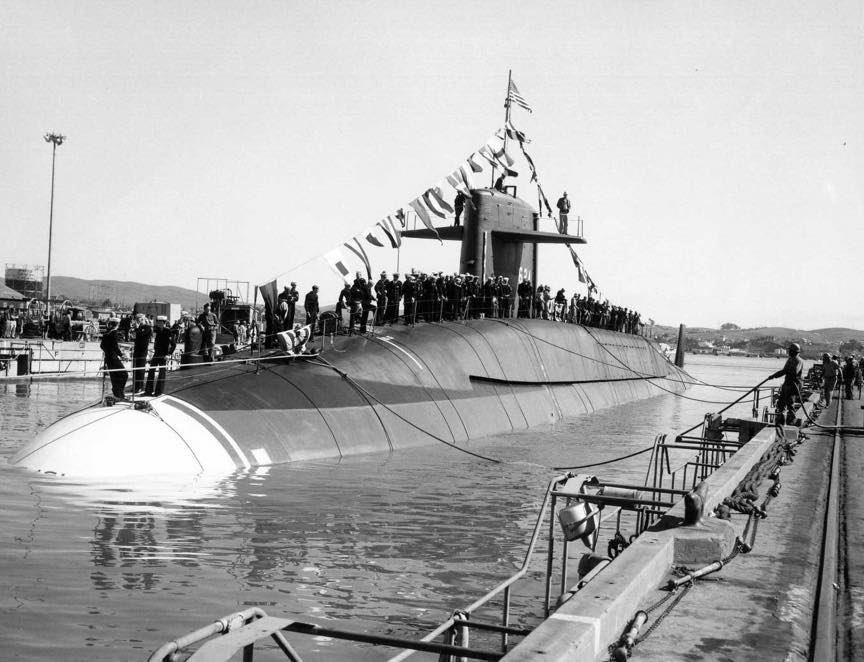
Woodrow Wilson
(SSBN-624: dp. 7,250 (surf.), 8,220 (subm.), 1. 425';b. 33' dr. 31'4", s. 16 k. (surf.), 20+ (subm.)cpl. l40 a. 16 Polaris mist, 4 tt.; cl. Lafayette)
Woodrow Wilson (SSBN-624) was laid down on 16 September 1961 at Vallejo, Calif., by the Mare Island Naval Shipyard launched on 22 February 1963 sponsored by Miss Eleanor A. Sayre, the granddaughter of President Wilson; and commissioned on 27 December 1963, Comdr. C. N. Mitchell and Comdr. W. N. Dietzen in command of the Blue and Gold crews, respectively.
Woodrow Wilson departed Vallejo, Calif., on 9 January 1964, bound for the east coast on a route which would take her through the Panama Canal. After stopping briefly at San Diego the submarine proceeded on to Panama arriving on ;9 January at the west coast end of the canal. Violent anti-American demonstrations and riots over a recent flag-displaying incident had resulted in an extremely tense atmosphere. As a result, the submarine transited the canal in a record seven hours and ten minutes while combat-ready marines and soldiers guarded the locks
Making port at Charleston, S.C., on 5 February, the Woodrow Wilson conducted shakedown off the lower eastern seaboard into March and underwent her postshakedown availability into April. She put to sea at the end of May upon the conclusion of these repairs and alterations and commenced her first deterrent patrol out of Charleston in June.
Woodrow Wilson subsequently operated in the Atlantic until the autumn of 1969 conducting her patrols from forward bases at Rota, Spain, and Holy Loch, Scotland. She was then transferred to the Pacific and arrived at Pearl Harbor on 19 November, via Charleston and the Panama Canal. The fleet ballistic missile submarine continued toward the western Pacific to be based at Guam. She conducted deterrent patrols from Apra Harbor through 1972. In that year, she shifted back to the Atlantic and served with the Atlantic Fleet into 1978. Between 1964 and 1977, the ship performed 37 deterrent patrols.
On 4 June 1979, Woodrow Wilson ran aground in heavy fog at Race Rock while en route to New London, Connecticut. The submarine was able to free itself and proceed to port for inspection of the damage.
After several overhauls in the Charleston Naval Shipyard and 40 more deterrent patrols, Woodrow Wilson entered the Charleston Naval Shipyard for its final refueling overhaul in 1988. CDR Charles Peterson was relieved of both crews by CDR Glen Dilgren in August of 1989. Hurricane Hugo struck on September 21, 1989 and resulted in a one month shipyard shutdown. During the shutdown, crew members were assigned to help with recovery operations in the Charleston area, for which the ship was awarded the Humanitarian Service Medal. During Alfa sea trials in June of 1990 and as a result of the Strategic Arms Reduction Treaty, Woodrow Wilson was directed to condense the crew, deactivate the missile systems and convert to an SSN. The ship was delivered for SSN Shakedown three months ahead of schedule.
During shakedown, the ship went 11-for-11 during AUTEC, WSAT and open ocean exercise torpedo firings against maneuvering targets. The missile compartment was configured for support of Naval Special Warfare, and the ship passed its initial SSN Tactical Readiness Evaluation. Following shakedown, the ship was assigned to Submarine Squadron Four at Charleston, SC and won the White "A" for excellence in Anti-Submarine Warfare. Woodrow Wilson was assigned missions in Fleet and NATO Exercises, Atlantic SSN Operations and a primary tasking in the development of new submarine and Naval Special Warfare tactics. In September of 1991, the ship was a key participant in Exercise Phantom Shadow, the largest ever Navy and Special Warfare exercise, which lasted a month in the Western Atlantic and Caribbean. In the spring of 1992, Woodrow Wilson conducted a successful MK 48 warshot SINKEX during her 30th underway since completion of overhaul two years before. CDR Glen Dilgren was relieved by CDR Marshall Page in April of 1992. During her final years of service, the ship continued SSN operations in the Atlantic, Mediterranean, and Caribbean.
Decommissioning and disposal
Woodrow Wilson was deactivated in September 1993. She was decommissioned on 1 September 1994 and stricken from the Naval Vessel Register the same day. Ex-Woodrow Wilson entered the Nuclear Powered Ship and Submarine Recycling Program at Bremerton, Washington, on 26 September 1997. Recycling of Ex-Woodrow Wilson was completed on 27 October 1998.
